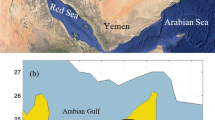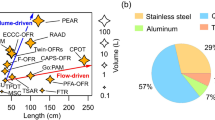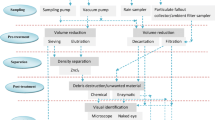Abstract
Size distribution, water-soluble inorganic ions (WSII), and organic carbon (OC) and elemental carbon (EC) in size-segregated aerosols were investigated during a year-long sampling in 2010 over New Delhi. Among different size fractions of PM10, PM0.95 was the dominant fraction (45%) followed by PM3–7.2 (20%), PM7.2–10 (15%), PM0.95–1.5 (10%), and PM1.5–3 (10%). All size fractions exceeded the ambient air quality standards of India for PM2.5. Annual average mass size distributions of ions were specific to size and ion(s); Ca2+, Mg2+, K+, NO3 −, and Cl− followed bimodal distribution while SO4 2− and NH4 + ions showed one mode in PM0.95. The concentrations of secondary WSII (NO3 −, SO4 2−, and NH4 +) increased in winters due to closed and moist atmosphere whereas open atmospheric conditions in summers lead to dispersal of pollutants. NH4 +and Ca2+were dominant neutralization ions but in different size fractions. The summer-time dust transport from upwind region by S SW winds resulted in significantly high concentrations of PM0.95 and PM3–7.2 and PM7.2–10. This indicted influence of dust generation in Thar Desert and its transport is size selective in nature in downwind direction. The mixing of different sources (geogenic, coal combustions, biomass burning, plastic burning, incinerators, and vehicular emissions sources) for soluble ions in different size fractions was noticed in principle component analysis. Total carbon (TC = EC + OC) constituted 8–31% of the total PM0.95 mass, and OC dominated over EC. Among EC, char (EC1) dominated over soot (EC2 + EC3). High SOC contribution (82%) to OC and OC/EC ratio of 2.7 suggested possible role of mineral dust and high photochemical activity in SOC production. Mass concentrations of aerosols and WSII and their contributions to each size fraction of PM10 are governed by nature of sources, emission strength of source(s), and seasonality in meteorological parameters.






Similar content being viewed by others
References
Andreae MO, Gelencsér A (2006) Black carbon or brown carbon? The nature of light-absorbing carbonaceous aerosols. Atmos Chem and Phys 6:3131–3148
Attri AK, Kumar U, Jain VK (2001) Formation of ozone by fireworks. Nature 411:2015
Bian H, Tie XX, Cao JJ, Ying ZM, Han SQ, Xue Y (2011) Analysis of a severe dust storm event over China: application of WRF-dust model. Aerosol Air Qual Res 11:419–428
Cao JJ, Lee SC, Ho KF, Zhang XY, Zou SC, Fung K, Chow JC, Watson JG (2003) Characteristics of carbonaceous aerosol in Pearl River Delta Region, China during 2001 winter period. Atmos Environ 37(11):1451–1460. https://doi.org/10.1016/S1352-2310(02)01002-6
Cao JJ, Wu F, Chow JC, Lee SC, Li Y, Chen SW, An ZS, Fung KK, Watson JG, Zhu CS, Liu SX (2005) Characterization and source apportionment of atmospheric organic and elemental carbon during fall and winter of 2003 in Xi’an, China. Atmos Chem Phys 5(11):3127–3137. https://doi.org/10.5194/acp-5-3127-2005
Cao JJ, Lee SC, Chow JC, Watson JG, Ho KF, Zhang RJ, Jin ZD, Shen ZX, Chen GC, Kang YM, ZouSC (2007) Spatial and seasonal distributions of carbonaceous aerosols over China. J Geophys Res 112:D22S11. https://doi.org/10.1029/2006JD008205
Chow JC, Watson JG, Chen LWA, Arnott WP, Moosmüller H, Fung K (2004) Equivalence of elemental carbon by thermal/optical reflectance and transmittance with different temperature protocols. Environ Sci Technol 38(16):4414–4422. https://doi.org/10.1021/es034936u
Chow JC, Watson JG, Chen LWA, Chang MO, Robinson NF, Trimble D, Kohl S (2007) The IMPROVE_A temperature protocol for thermal/optical carbon analysis: maintaining consistency with a long-term database. J Air Waste Manag Assoc 57(9):1014–1023. https://doi.org/10.3155/1047-3289.57.9.1014
Clegg SL, Brimblecombe P, Wexler AS (1998) Thermodynamic model of the system H+ NH4 + SO4 2− NO3 − H2O at tropospheric temperatures. J Phys Chem A 102(12):2137–2154. https://doi.org/10.1021/jp973042r
Cong Z, Kawamura K, Kang S, Fu P (2015) Penetration of biomass-burning emissions from South Asia through the Himalayas: new insights from atmospheric organic acids. Sci Rep 5(1). https://doi.org/10.1038/srep09580
Deshmukh DK, Tsai YI, Deb MK, Mkoma SL (2012) Characterization of dicarboxylates and inorganic ions in urban PM10 aerosols in the Eastern Central India. Aerosol Air Qual Res 12:592–607
Dordevic D, Mihajlidi-Zelic A, Relic D, Ignjatovi L, Huremovi J, Stortini AM, Gambaro A (2012) Size-segregated mass concentration and water soluble inorganic ions in an urban aerosol of the Central Balkans (Belgrade). Atmos Environ 46:309–317. https://doi.org/10.1016/j.atmosenv.2011.09.057
Draxler R and Rolph G (2013) HYSPLIT (HYbrid Single-Particle Lagrangian Integrated Trajectory), NOAA Air Resources Laboratory, College Park, MD. Model access via NOAA ARL READY Website
Feng YW, Ogura N, Feng ZW, Zhang FZ, Shimizu H (2003) The concentrations and sources of fluoride in atmospheric depositions in Beijing, China. Water Air Soil Pollut 145(1):95–107. https://doi.org/10.1023/A:1023680112474
Galindo N, Gil-Moltó J, Varea M, Chofre C, Yubero E (2013) Seasonal and interannual trends in PM levels and associated inorganic ions in southeastern Spain. Microchem J 110:81–88. https://doi.org/10.1016/j.microc.2013.02.009
Gu J, Bai Z, Liu A, Wu L, Xie Y, Li W, Dong H, Zhang X (2010) Characterization of atmospheric organic carbon and element carbon of PM2.5 and PM10 at Tianjin, China. Aerosol Air Qual Res 10:167–176
Guo S, Hu M, Wang ZB, Slanina J, Zhao YL (2010) Size-resolved aerosol water-soluble ionic compositions in the summer of Beijing: implication of regional secondary formation. AtmosChemPhys 10:947–959
Guttikunda SK, Goel R (2013) Health impacts of particulate pollution in a megacity—Delhi, India. Environ Dev 6:8–20. https://doi.org/10.1016/j.envdev.2012.12.002
Guttikunda SK, Jawahar P (2014) Atmospheric emissions and pollution from the coal-fired thermal power plants in India. Atmos Environ 92:449–460. https://doi.org/10.1016/j.atmosenv.2014.04.057
Han YM, Cao JJ, Lee SC, Ho KF, An ZS (2010a) Different characteristics of char and soot in the atmosphere and their ratio as an indicator for source identification in Xi’an. China Atmos Chem Phys 10(2):595–607. https://doi.org/10.5194/acp-10-595-2010
Han YM, Cao JJ, Lee SC, Ho KF, An ZS (2010b) Different characteristics of char and soot in the atmosphere and their ratio as an indicator for source identification in Xi’an, China. Atmos Chem Phys 10(2):595–607. https://doi.org/10.5194/acp-10-595-2010
Hu D, Chen J, Ye X, Li L, Yang X (2011) Hygroscopicity and evaporation of ammonium chloride and ammonium nitrate: relative humidity and size effects on the growth factor. Atmos Environ 45(14):2349–2355. https://doi.org/10.1016/j.atmosenv.2011.02.024
Huang X, Liu Z, Zhang J, Wen T, Ji D, Wang Y (2016) Seasonal variation and secondary formation of size-segregated aerosol water-soluble inorganic ions during pollution episodes in Beijing. Atmos Res 168:70–79. https://doi.org/10.1016/j.atmosres.2015.08.021
Keene WC, Pszenny AAP, Maben JR (2004) Closure evaluation of size-resolved aerosol pH in the New England coastal atmosphere during summer. J Geophys Res 109:2156–2202
Khoder MI (2002) Atmospheric conversion of sulfur dioxide to particulate sulfate and nitrogen dioxide to particulate nitrate and gaseous nitric acid in an urban area. Chemosphere 49(6):675–684. https://doi.org/10.1016/S0045-6535(02)00391-0
Kim E, Hopke PK (2004) Source apportionment of fine particles in Washington, DC, utilizing temperature-resolved carbon fractions. J Air Waste Manag Assoc 54(7):773–785. https://doi.org/10.1080/10473289.2004.10470948
Kim IG, Jo BH, Kang DG, Kim CS, Choi YS, Cha HJ (2012) Biomineralization-based conversion of carbon dioxide to calcium carbonate using recombinant carbonic anhydrase. Chemosphere 87(10):1091–1096. https://doi.org/10.1016/j.chemosphere.2012.02.003
Kiss G, Varga B, Galambos GI (2002) Characterization of water-soluble organic matter isolated from atmospheric fine aerosol. J Geophys Res-Atmos 107(D21):ICC 1-1–ICC 1-8. https://doi.org/10.1029/2001JD000603
Kolb CE, Worsnop DR (2012) Chemistry and composition of atmospheric aerosol particles. Annu Rev Phys Chem 63(1):471–491. https://doi.org/10.1146/annurev-physchem-032511-143706
Kong S, Wen B, Chen K, Yin Y, Li L, Li Q, Yuan L, Li X, Sun X (2014) Ion chemistry for atmospheric size-segregated aerosol and depositions at an offshore site of Yangtze River Delta region, China. Atmos Res 147:205–226
Krupa SV (2003) Effects of atmospheric ammonia (NH3) on terrestrial vegetation: a review. Environ Pollut 124(2):179–221. https://doi.org/10.1016/S0269-7491(02)00434-7
Kumar P, Yadav S (2016) Seasonal variations in water soluble inorganic ions, OC and EC in PM10 and PM > 10 aerosols over Delhi: influence of sources and meteorological factors. Aerosol Air Qual Res 16(5):1165–1178. https://doi.org/10.4209/aaqr.2015.07.0472
Kumar R, Srivastava SS, Kumari KM (2007) Characteristics of aerosols over suburban and urban site of semiarid region in India: seasonal and spatial variations. Aerosol Air Qual Res 7(4):531–549. https://doi.org/10.4209/aaqr.2007.02.0010
Kumar P, Yadav S, Kumar A (2014) Sources and processes governing rainwater chemistry in New Delhi. India Nat Hazards 74(3):2147–2162. https://doi.org/10.1007/s11069-014-1295-0
Kumar S, Aggarwal SG, Gupta PK, Kawamura K (2015) Investigation of the tracers for plastic-enriched waste burning aerosols. Atmos Environ 108:49–58. https://doi.org/10.1016/j.atmosenv.2015.02.066
Kumar P, Kumar R, Yadav S (2016) Water-soluble ions and carbon content of size-segregated aerosols in New Delhi, India: direct and indirect influences of firework displays. Environ Sci Pollut Res Int 23(20):20749–20760. https://doi.org/10.1007/s11356-016-7313-x
Kunkel D, Tost H, Lawrence MG (2013) Aerosol pollution potential from major population centers. Atmos Chem Phys 13(8):4203–4222. https://doi.org/10.5194/acp-13-4203-2013
Li X, Wang L, Ji D, Wen T, Pan Y, Sun Y, Wang Y (2013) Characterization of the size-segregated water-soluble inorganic ions in the Jing-Jin-Ji urban agglomeration: spatial/temporal variability, size distribution and sources. Atmos Environ 77:250–259. https://doi.org/10.1016/j.atmosenv.2013.03.042
Li L, Li M, Huang Z, Gao W, Nian H, Fu Z, Gao J, Chai F, Zhou Z (2014) Ambient particle characterization by single particle aerosol mass spectrometry in an urban area of Beijing. Atmos Environ 94:323–331. https://doi.org/10.1016/j.atmosenv.2014.03.048
Lim HJ, Turpin BJ (2002) Origins of primary and secondary organic aerosol in Atlanta: results of time-resolved measurements during the Atlanta supersite experiment. Environ Sci Technol 36:4489–4496
Lim S, Lee M, Lee G, Kim S, Yoon S, Kang K (2012) Ionic and carbonaceous compositions of PM 10, PM 2.5 and PM 1.0 at Gosan ABC superstation and their ratios as source signature. Atmos Chem Phys 12(4):2007–2024. https://doi.org/10.5194/acp-12-2007-2012
Lin JJ, Tai HS (2001) Concentrations and distributions of carbonaceous species in ambient particles in Kaohsiung City, Taiwan. Atmos Environ 35(15):2627–2636. https://doi.org/10.1016/S1352-2310(00)00444-1
Liu S, Hu M, Slanina S, He LY, Niu YW, Bruegemann E, Gnauk T, Herrmann H (2008) Size distribution and source analysis of ionic compositions of aerosols in polluted periods at Xinken in Pearl River Delta (PRD) of China. Atmos Environ 42(25):6284–6295. https://doi.org/10.1016/j.atmosenv.2007.12.035
Ma J, Xu X, Zhao C, Yan P (2012) A review of atmospheric chemistry research in China: photochemical smog, haze pollution, and gas-aerosol interactions. Adv Atmos Sci 29:1006–1026
Mandal P, Saud T, Sarkar R, Mandal A, Sharma SK, Mandal TK, Bassin JK (2014) High seasonal variation of atmospheric C and particle concentrations in Delhi, India. Environ Chem Lett 12(1):225–230. https://doi.org/10.1007/s10311-013-0438-y
Mihajlidi-Zelic A, Dordevic D, Relic D, Tosic I, Ignjatovic L, Stortini MA, Gambaro A (2015) Water-soluble inorganic ions in urban aerosols of the continental part of Balkans (Belgrade) during the summer–autumn (2008). Open Chem 13:245–256
Mozurkewich M (1993) The dissociation constant of ammonium nitrate and its dependence on temperature, relative humidity and particle size. Atmos Environ Part Gen Top 27(2):261–270. https://doi.org/10.1016/0960-1686(93)90356-4
NAAQS (2009) National Ambient Air Quality Standards, Central Pollution Control Board, New Delhi, India. http://cpcb.nic.in/National_Ambient_Air_Quality_Standards.php
Novakov T, Menon S, Kirchstetter TW, Koch D, Hansen JE (2005) Aerosol organic carbon to black carbon ratios: analysis of published data and implications for climate forcing. J Geophys Res 110:D21205. https://doi.org/10.1029/2005JD005977
Oh MS, Lee TJ, Kim DS (2011) Quantitative source apportionment of size-segregated particulate matter at urbanized local site in Korea. Aerosol Air Qual Res 11:247–264
Ooki A, Uematsu M (2005) Chemical interactions between mineral dust particles and acid gases during Asian dust events. J Geophys Res-Atmos 110(D3). https://doi.org/10.1029/2004JD004737
Panicker AS, Ali K, Beig G, Yadav S (2015) Characterization of particulate matter and carbonaceous aerosol over two urban environments in Northern India. Aerosol Air Qual Res 15:2584–2595
Pant P, Shukla A, Kohl SD, Chow JC, Watson JG, Harrison RM (2015) Characterization of ambient PM2.5 at a pollution hotspot in New Delhi, India and inference of sources. Atmos Environ 109:178–189. https://doi.org/10.1016/j.atmosenv.2015.02.074
Pathak RK, WS W, Wang T (2009) Summertime PM 2.5 ionic species in four major cities of China: nitrate formation in an ammonia-deficient atmosphere. Atmos Chem Phys 9(5):1711–1722. https://doi.org/10.5194/acp-9-1711-2009
Platt SM, Haddad IE, Zardini AA, Clairotte M, Astorga C, Wolf R, Slowik JG, Temime-Roussel B, Marchand N, Jezek I, Drinovec L (2013) Secondary organic aerosol formation from gasoline vehicle emissions in a new mobile environmental reaction chamber. Atmos Chem Phys 13(18):9141–9158. https://doi.org/10.5194/acp-13-9141-2013
Ram K, Sarin MM (2010) Spatio-temporal variability in atmospheric abundances of EC, OC and WSOC over Northern India. J Aerosol Sci 41(1):88–98. https://doi.org/10.1016/j.jaerosci.2009.11.004
Ram K, Sarin MM, Hegde P (2008) Atmospheric abundances of primary and secondary carbonaceous species at two high-altitude sites in India: sources and temporal variability. Atmos Environ 42(28):6785–6796. https://doi.org/10.1016/j.atmosenv.2008.05.031
Ram K, Sarin MM, Sudheer AK, Rengarajan R (2012) Carbonaceous and secondary inorganic aerosols during wintertime fog and haze over urban sites in the Indo-Gangetic Plain. Aerosol Air Qual Res 12:359–370
Rastogi N, Sarin MM (2009) Quantitative chemical composition and characteristics of aerosols over western India: one-year record of temporal variability. Atmos Environ 43(22-23):3481–3488. https://doi.org/10.1016/j.atmosenv.2009.04.030
Rastogi N, Singh A, Sarin MM, Singh D (2016) Temporal variability of primary and secondary aerosols over northern India: impact of biomass burning emissions. Atmos Environ 125:396–403. https://doi.org/10.1016/j.atmosenv.2015.06.010
Rengarajan R, Sarin MM, Sudheer AK (2007) Carbonaceous and inorganic species in atmospheric aerosols during wintertime over urban and high-altitude sites in North India. J Geophys Res-Atmos 112(D21). https://doi.org/10.1029/2006JD008150
Safai PD, RajuM P, Rao PSP, Pandithurai G (2014) Characterization of carbonaceous aerosols over the urban tropical location and a new approach to evaluate their climatic importance. Atmos Environ 92:493–500. https://doi.org/10.1016/j.atmosenv.2014.04.055
Shen Z, Han Y, Cao J, Tian J, Zhu C, Liu S, Liu P, Wang Y (2010) Characteristics of traffic-related emissions: a case study in roadside ambient air over Xi’an, China. Aerosol Air Qual Res 10:292–300
Shridhar V, Khillare PS, Agarwal T, Ray S (2010) Metallic species in ambient particulate matter at rural and urban location of Delhi. J Hazard Mater 175(1-3):600–607. https://doi.org/10.1016/j.jhazmat.2009.10.047
Silvern RF, Jacob DJ, Kim PS, Marais EA, Turner JR, Campuzano-Jost P, Jimenez JL (2017) Inconsistency of ammonium-sulfate aerosol ratios with thermodynamic models in the eastern US: a possible role of organic aerosol. Atmos Chem Phys 17(8):5107–5118. https://doi.org/10.5194/acp-17-5107-2017
Singh RP, Kaskaoutis DG (2014) Crop residue burning: a threat to South Asian air quality. Eos Trans Am Geophys 95(37):333–334. https://doi.org/10.1002/2014EO370001
Tandon A, Yadav S, Attri AK (2010) Coupling between meteorological factors and ambient aerosol load. Atmos Environ 44:1237–1243
Tao Y, Yin Z, Ye X, Ma Z, Chen J (2014) Size distribution of water-soluble inorganic ions in urban aerosols in Shanghai. Atmos Pollut Res 5(4):639–647. https://doi.org/10.5094/APR.2014.073
Tare V, Tripathi SN, Chinnam N, Srivastava AK, Dey S, Manar M, Kanawade VP, Agarwal A, Kishore S, Lal RB, Sharma M (2006) Measurements of atmospheric parameters during Indian Space Research Organization Geosphere Biosphere Program Land Campaign II at a typical location in the Ganga Basin: 2. chemical properties. J Geophys Res 111:D23209. https://doi.org/10.1029/2006JD007278
Theodosi C, Grivas G, Zarmpas P, Chaloulakou A, Mihalopoulos N (2011) Mass and chemical composition of size-segregated aerosols (PM1, PM2.5, PM10) over Athens, Greece: local versus regional sources. Atmos Chem Phys 11(22):11895–11911. https://doi.org/10.5194/acp-11-11895-2011
Trivedi DK, Ali K, Beig G (2014) Impact of meteorological parameters on the development of fine and coarse particles over Delhi. Sci Total Environ 478:175–183. https://doi.org/10.1016/j.scitotenv.2014.01.101
Tsai JH, Lin JH, Yao YC, Chiang HL (2012) Size distribution and water soluble ions of ambient particulate matter on episode and non-episode days in Southern Taiwan. Aerosol Air Qual Res 12:263–274
Tsai JH, Chang LP, Chiang HL (2013) Size mass distribution of water-soluble ionic species and gas conversion to sulfate and nitrate in particulate matter in southern Taiwan. Environ Sci Pollut Res Int 20(7):4587–4602. https://doi.org/10.1007/s11356-012-1371-5
Turpin BJ, Lim HJ (2001) Species contributions to PM2.5 mass concentrations: Revisiting common assumptions for estimating organic mass. Aerosol Sci Technol 35:602-610
Wang Y, Zhuang G, Sun Y, An Z (2005) Water-soluble part of the aerosol in the dust storm season-evidence of the mixing between mineral and pollution aerosols. Atmos Environ 39(37):7020–7029. https://doi.org/10.1016/j.atmosenv.2005.08.005
WHO (2005) World Health Organization air quality guidelines global update 2005. Report E87950, 25
Xia L, Gao Y (2010) Chemical composition and size distributions of coastal aerosols observed on the US East Coast. Mar Chem 119(1-4):77–90. https://doi.org/10.1016/j.marchem.2010.01.002
Xiu G, Zhang D, Chen J, Huang X, Chen Z, Guo H, Pan J (2004) Characterization of major water-soluble inorganic ions in size-fractionated particulate matters in Shanghai campus ambient air. Atmos Environ 38(2):227–236. https://doi.org/10.1016/j.atmosenv.2003.09.053
Yadav S, Rajamani V (2004) Geochemistry of aerosols of northwestern part of India adjoining the Thar Desert. Geochim Cosmochim Acta 68(9):1975–1988. https://doi.org/10.1016/j.gca.2003.10.032
Yadav S, Rajamani V (2006) Air quality and trace metal chemistry of different size fractions of aerosols in N–NW India-implications for source diversity. Atmos Environ 40:698–712
Yadav S, Tandon A, Attri AK (2013) Monthly and seasonal variations in aerosol associated n-alkane profiles in relation to meteorological parameters in New Delhi, India. Aerosol Air Qual Res 13:287–300
Yadav S, Tandon A, Tripathi JK, Yadav S, Attri AK (2016) Statistical assessment of respirable and coarser size ambient aerosol sources and their timeline trend profile determination: a four year study from Delhi. Atmos Pollut Res 7(1):190–200. https://doi.org/10.1016/j.apr.2015.08.010
Yttri KE, Aas W, Bjerke A, Cape JN, Cavalli F, Ceburnis D, Torseth K (2007) Elemental and organic carbon in PM : a one year measurement campaign within the European Monitoring and Evaluation Programme EMEP. Atmos Chem and Phys 7:5711–5725
Yu JZ, Xu J, Yang H (2002) Charring characteristics of atmospheric organic particulate matter in thermal analysis. Environ Sci Technol 36(4):754–761. https://doi.org/10.1021/es015540q
Zhang L, Vet R, Wiebe A, Mihele C, Sukloff B, Chan E, Moran MD, Iqbal S (2008) Characterization of the size-segregated water-soluble inorganic ions at eight Canadian rural sites. Atmos Chem Phys 8(23):7133–7151. https://doi.org/10.5194/acp-8-7133-2008
Zhao J, Zhang F, Xu Y, Chen J (2011) Characterization of water-soluble inorganic ions in size-segregated aerosols in coastal city, Xiamen. Atmos Res 99(3-4):546–562. https://doi.org/10.1016/j.atmosres.2010.12.017
Zhu CS, Cao JJ, Tsai CJ, Shen ZX, Han YM, Liu SX, Zhao ZZ (2014) Comparison and implications of PM2.5 carbon fractions in different environments. Sci Total Environ 466:203–209
Acknowledgements
The authors are greatful to two anonymous reviewers for their critical comments and help in improving the quality of MS. The extra mural research project grants (24(0316)/11-EMR-II) received from the Council of Scientific and Industrial Research (CSIR), New Delhi, for carrying this work are duly acknowledged. PK and SK are also thankful to the CSIR and University Grants Commission, respectively, for research fellowship during this work.
Author information
Authors and Affiliations
Corresponding author
Additional information
Responsible editor: Gerhard Lammel
Electronic supplementary material
ESM 1
(DOCX 27kb).
Rights and permissions
About this article
Cite this article
Kumar, P., Kumar, S. & Yadav, S. Seasonal variations in size distribution, water-soluble ions, and carbon content of size-segregated aerosols over New Delhi. Environ Sci Pollut Res 25, 6061–6078 (2018). https://doi.org/10.1007/s11356-017-0954-6
Received:
Accepted:
Published:
Issue Date:
DOI: https://doi.org/10.1007/s11356-017-0954-6




